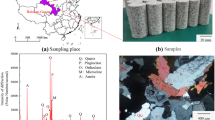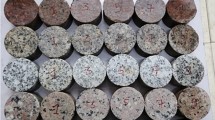Abstract
Deep geological disposal of high-level radioactive waste is a feasible method for solving the problem of spent fuel storage in China. High-level radioactive waste releases heat during the decay process, which increases the temperature of the surrounding rock in the repository, resulting in a significant increase in radon concentration. In this study, the surrounding rock (granite) of a high-level radioactive waste repository was taken as the research object and, based on the similarity principle, an orthogonal test designed. Similar materials of uranium-containing granite were prepared in the laboratory and the physical and mechanical properties and cumulative radon concentration of granite samples assessed under different temperatures (25, 50, 100, 150, and 200 °C). The results showed that, with increased temperature, the compressive and tensile strengths of samples gradually increased and their pore volume gradually decreased. After heat treatment, the longitudinal wave velocity and thermal conductivity of samples decreased linearly with increased temperature. The radon exhalation rate first increased and then decreased, with the rate reaching a maximum at 100 °C. The radon exhalation rate of single-sided and double-sided samples was 0.00914 and 0.00460 Bq·m−2·s−1, respectively. When the temperature was 25–100 °C, the dominant stage was pore water. The radon exhalation rates of samples were positively correlated with compressive and tensile strengths and negatively correlated with pore volume, longitudinal wave velocity, and thermal conductivity. The temperature of 100–200 °C was range of the dominant stage of pore structure. The conclusions obtained in this study can provide theoretical support for radon reduction and radon control of granite in high temperature environments.
















Similar content being viewed by others
Data availability
All data generated or analyses during this study are included in this published article.
References
Amit K, Chauhan RP (2014) Active and passive measurements of radon diffusion coefficient from building construction materials. Environ Earth Sci 72:251–257. https://doi.org/10.1007/s12665-013-2951-5
Aurélien N, Frédéric G, Alexandre S, Éric P, François P, Jérôme F, Damien D (2014) Radon emanation from brittle fracturing in granites under upper crustal conditions. Geophys Res Lett 41(15):5436–5443. https://doi.org/10.1002/2014GL061095
Belikov VT, Utkin VI, Kozlova IA, Ryvkin DG, Yurkov AK (2013) Experimental and theoretical study of radon emanation when destructing rock specimens. Dokl Earth Sci 450:548–549. https://doi.org/10.1134/S1028334X13050152
Cong HL (2008) Strategy for high level waste management in China. J Nucl Sci Technol 45(sup5):16–19. https://doi.org/10.1080/00223131.2008.10875774
Cui Y, Feng SY, Chen PX, Ye YJ, Wu YR, Li C, Yang R, Wang H (2020) Heat-air-moisture coupled model for radon migration in a porous media. Environ Sci Pollut Res 27:32659–32669. https://doi.org/10.1007/s11356-020-09374-z
Duan LM, Zhang YH, Lai JX (2019) Influence of ground temperature on shotcrete-to-rock adhesion in tunnels. Adv Mater Sci Enghttps://doi.org/10.1155/2019/8709087
Dwivedi RD, Goel RK, Prasad VVR (2008) Thermo-mechanical properties of Indian and other granites. Int J Rock Mech Min Sci 45(3):303–315. https://doi.org/10.1016/J.IJRMMS.2007.05.008
Fang XY, Xu JY, Liu S, Wang HY (2019) Influence of heating on tensile physical-mechanical properties of granite. High Temp Mater Processes (london) 38:505–515. https://doi.org/10.1515/htmp-2017-0093
Fergus GFG, Karl PT, Neil AMT, David B, Kevin WH (2008) Modeling temperature distribution around very deep borehole disposals of HLW. Nuclear Technology 163(1): 62–73. https://doi.org/10.13182/NT08-A3970
GBZ 116–2002 (2002) Standard for the control of radon and its progeny in underground buildings [S]. Beijing: China Standard Press
Jiang FL, Wang Z, Chen G, Liu Y, Wu HN, Tan B, Luo CW (2021) Experimental study of pore characteristics and radon exhalation of uranium tailing solidified bodies in acidic environments. Environ Sci Pollut Res 28:20111–20120. https://doi.org/10.1007/s11356-020-12039-6
Jiao PF, Zhang X, Li XZ, Liu BH, Zhang HJ (2018) Experimental study on the ratio of similar materials in weak surrounding rock based on orthogonal design. J Eng 6. https://doi.org/10.1155/2018/2591758
Kadir A, Zhang L, Guo Q, Liang J (2013) Efficiency analysis and comparison of different radon progeny measurement methods. Scientific World Journal. Dec 5; 2013:269168. https://doi.org/10.1155/2013/269168
Kilic Ö (2006) The influence of high temperatures on limestone P wave velocity and Schmidt hammer strength. Int J Rock Mech Min Sci 43(6):980–986. https://doi.org/10.1016/J.IJRMMS.2005.12.013
Kozlova IA, Yurkov AK (2005) Soil-gas radon-222 monitoring: methodological issues[J]. Uralskii Geofizicheskii Vestnik 7:31–34
Ma CY, Zhu ZG, Fang ZC, Li ZB, Liu L (2021) Optimal proportion of similar materials and rockburst tendency of white sandstone. Adv Mater Sci Eng 17. https://doi.org/10.1155/2021/6590779
Narula AK, Goyal SK, Saini S, Chauhan RP, Chakarvarti SK (2009) Calculation of radon diffusion coefficient and diffusion length for different building construction materials. Indian J Phys 83:1171–1175. https://doi.org/10.1007/s12648-009-0097-9
Nikolic M, Simovic R (2015) Radon exhalation rates of some granites used in Serbia. Nucl Technol Rad Protect 30:145–148. https://doi.org/10.2298/NTRP1502145N
Rana MA (2009) Disposal of high level nuclear wastes: thermodynamic equilibrium and environment ethics. Nuclear Science and Techniques 20(03):188–192. https://doi.org/10.13538/j.1001-8042/nst.20.188-192
Rong G, Li BW, Quan JS, Chen ZH, Meng SQ, Peng J (2021) Effect of thermal damage on mechanical and permeability properties of sandstone. Arabian Journal of Geosciences 14(1772). https://doi.org/10.1007/s12517-021-08098-9
Shi YB, Ye YC, Hu NY, Xu H, Wang XH (2021) Experiments on material proportions for similar materials with high similarity ratio and low strength in multilayer shale deposits. Apply Sciences 11(9620). https://doi.org/10.3390/app11209620
Thierry R, Sevi GH, Michel D (2006) The effect of heating on the microstructural evolution of La Peyratte granite deduced from acoustic velocity measurements. Earth Planet Sci Lett 243(3):692–700. https://doi.org/10.1016/J.EPSL.2006.01.038
Wen CX, Jia SP, Fu XF, Meng LD, Zhao ZY (2020) Experimental research and sensitivity analysis of mudstone similar materials based on orthogonal design. Adv Mater Sci Eng. https://doi.org/10.1155/2020/2031276
Wu Y, Li XZ, Huang Z, Xue S (2021) Effect of temperature on physical, mechanical and acoustic emission properties of Beishan granite, Gansu Province, China. Nat Hazards 107:1577–1592. https://doi.org/10.1007/s11069-021-04647-3
Yang MZ, Yang Y, Zhao B (2021) Study on the proportion of conglomerate similar materials based on the orthogonal test. Shock and Vibrationhttps://doi.org/10.1155/2021/6657323
Ye YJ, Liu W, Huang CH, Liang T, Feng SY, Chen GL (2020) Radon migration in finite-thickness particle-packing emanation media. J Radioanal Nucl Chem 324:737–746. https://doi.org/10.1007/s10967-020-07095-8
Zhao YS, Cheng ZQ, Gao YT, Wu SC, Chen CC (2020) Review of geomechanical similar-material test systems. Arab J Geosci 13:906. https://doi.org/10.1007/s12517-020-05870-1
Funding
This research was supported by the Hunan Provincial Natural Science Foundation of China (grant nos. 2021JJ30572 and 2021JJ30206), the Research Foundation of Education Bureau of Hunan Province, China (grant no. 20A422), Hunan Provincial Innovation Foundation for Postgraduate, China (grant no. CX20210924), the Open Fund Project of Hunan Engineering Research Center for Uranium Exploration Technology (grant no. 2021HSKFJJ045), and the Innovation and Entrepreneurship Training Program for College Students in China (grant no. 202211528113) and the Innovation and Entrepreneurship Training Program for College Students in Hunan Province, China (grant no. S202211528055).
Author information
Authors and Affiliations
Contributions
Fuliang Jiang put forward the experimental scheme, guided the experiment, and guided the writing of the thesis. Yuying Hao carried out the field the experiments and completed the draft paper. Biao Tan, Chao Zhang, Mian Zhang, Haoyu Li and Xiaotong Yang participated in the field experiment. Yixiang Mo, Tao Hu, Shiyan Li and Huiting He participated in the discussion of the draft paper. All authors contributed to the writing of the manuscript and approved the final manuscript.
Corresponding author
Ethics declarations
Ethics approval
Since this study did not recruit any human and/or animal subjects, this section does not apply.
Consent to participate
Since this study did not recruit any human subjects, this section does not apply.
Consent for publication
Since this study is not attempting to re-publish/publish any third party or author’s previously published material, this section does not apply.
Competing interests
The authors declare no competing interests.
Additional information
Responsible Editor: Georg Steinhauser
Publisher's note
Springer Nature remains neutral with regard to jurisdictional claims in published maps and institutional affiliations.
Rights and permissions
Springer Nature or its licensor (e.g. a society or other partner) holds exclusive rights to this article under a publishing agreement with the author(s) or other rightsholder(s); author self-archiving of the accepted manuscript version of this article is solely governed by the terms of such publishing agreement and applicable law.
About this article
Cite this article
Hao, Y., Jiang, F., Tan, B. et al. Study on damage evolution and radon exhalation of uranium-bearing granite under high temperature. Environ Sci Pollut Res 30, 35223–35237 (2023). https://doi.org/10.1007/s11356-022-24740-9
Received:
Accepted:
Published:
Issue Date:
DOI: https://doi.org/10.1007/s11356-022-24740-9




